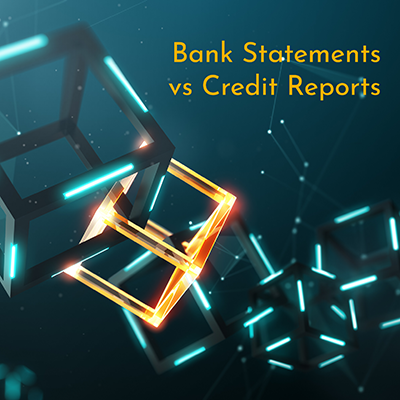
Bank Statements v Credit Reports
Your bank account information doesn’t show up on your credit report, nor does it impact your credit score. So why use a credit report first, when bank statement analysis can give you up-to-date, clear, and valuable information to determine whether you can take on more debt.
Every time you apply for a phone, internet, or credit of any kind, an entry is made on your credit report. If you are denied or your service is cancelled or overdue, it can and is usually added to your report, affecting your credit score and what lenders will offer you. Depending on the credit reporting agency that is used, your score will be between 0 and 1,000-1,200.
But a higher score means the lender will consider you a less risky and higher quality lender. This could mean getting a better deal and saving you money. But a lower score will affect your ability to get a loan or credit and could leave you in a difficult position that is hard to justify to lenders.
Allowing access to bank statement data can give a clear and current view of your financial situation, and offers can be tailored to what you can afford. It doesn’t affect your credit with a decision that can be quickly given.
When applying for loans or credit cards, lenders first look at your credit score and then your credit report to see your active, and settled or failed credit accounts and loans, details about your payment history, and more. They can also tell how much available credit you have right now, how much you’re using, if you’ve had any debt go to collections, along with the number of soft or hard inquiries on your account within the past two years. Those inquiries can be from a phone, bill, or even something you had no idea would involve your credit score.
But credit reports leave out essential data, we have sighted delays of up to six months for the listing to be updated on a client’s credit report. We have also found that information about assets such as checking account balances, savings account balances, deposits, individual retirement accounts, stocks, and other investments are not listed in your credit profile. This can leave clear gaps in reporting and accuracy, not always giving a realistic representation of the current financial state.
This is where your bank statements come into play.
Credfin has enhanced the risk assessment overview of consumers by providing bank statement scoring and metrics. The incorporation of bank statement-derived metrics can enhance decision-making, thereby improving the assessment of a consumer’s ability to repay a loan.
Credfin can combine financial data from multiple accounts to get a complete view of your customer’s finances. Identify all income sources, examine expenses and discover liabilities and risks quickly, thus giving you the ability to access critical financial data and insights.
The biggest advantage over credit reports as the data is up to date and not potentially six months old and thus a true reflection of the client’s financial situation. The credit report will give you historical trends with the client’s behaviour and probability of risk of default especially with the same type of credit.
So, while there will always be a place for credit reporting, it certainly isn’t the only option and shouldn’t be your first choice when it comes to a clear and real-time view of current financial circumstances.


